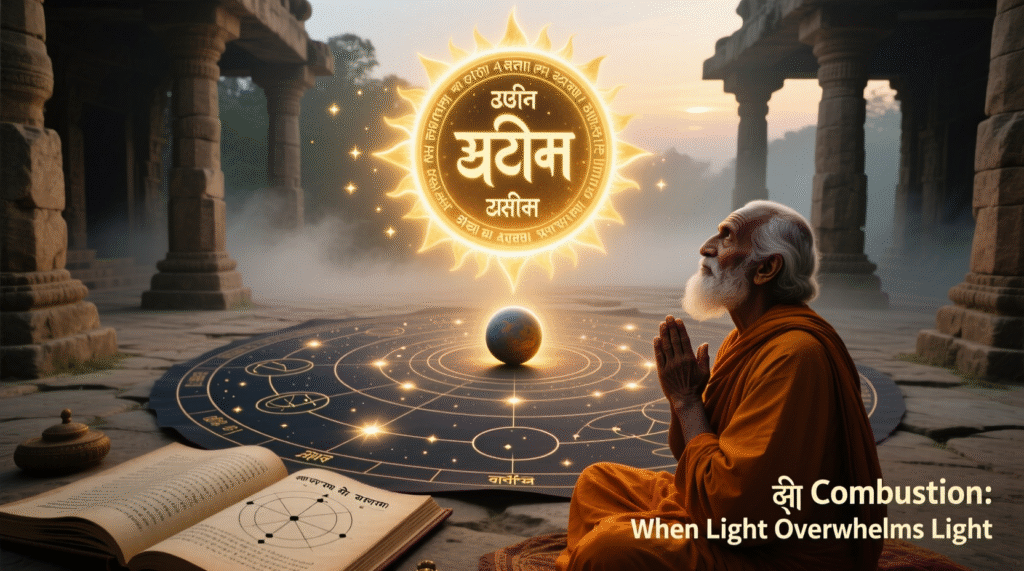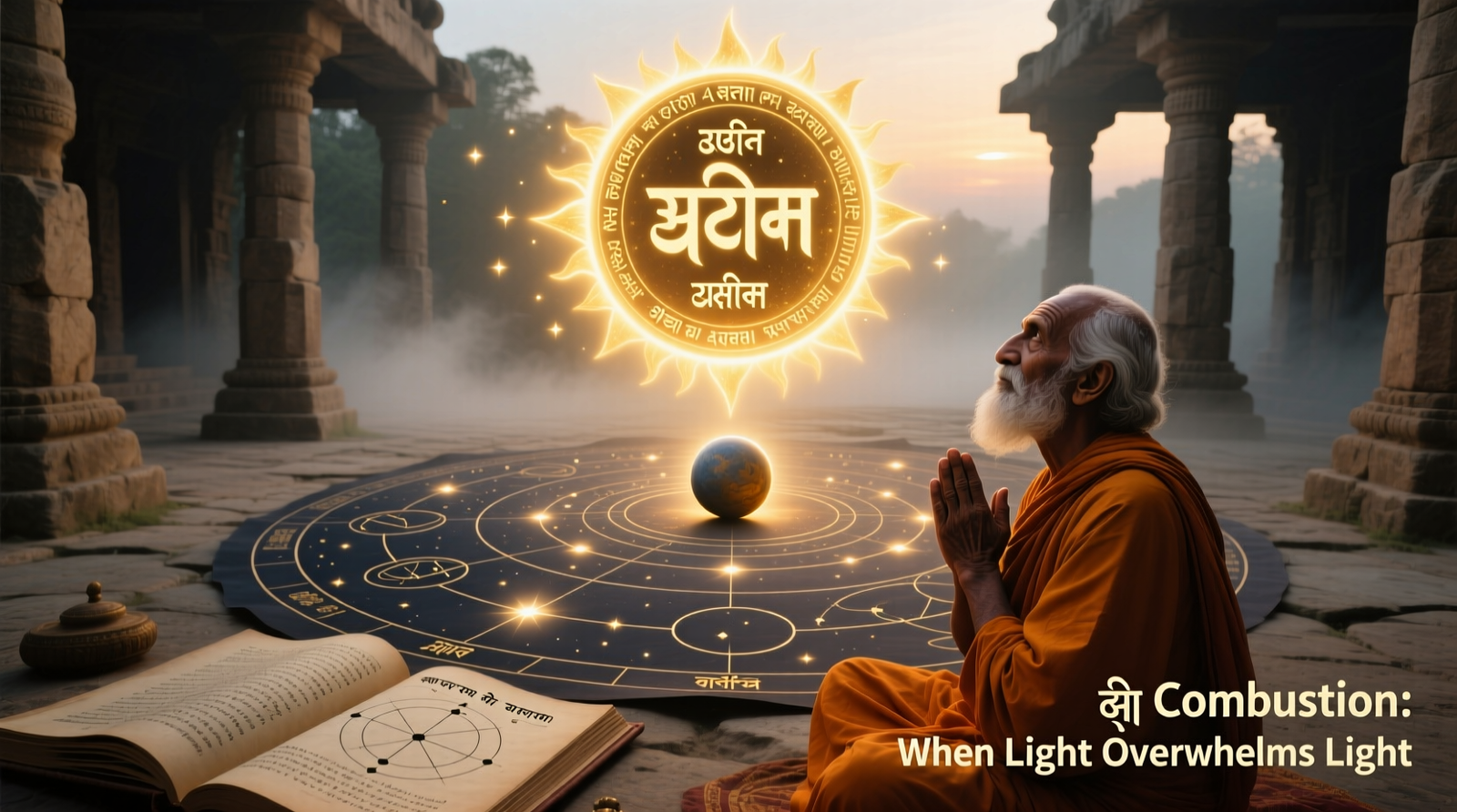Combust Planets in Astrology: Unveiling Their Hidden Influences and Paths to Harmony, the cosmos isn’t just a distant spectacle—it’s a mirror reflecting our inner lives, challenges, and potentials. At the heart of this system lies the concept of combust planets, a phenomenon that occurs when a planet draws too close to the Sun, losing its luster under the star’s overwhelming brilliance. This closeness, measured in degrees, strips the planet of its usual vigor, much like a flame too near the fire gets singed and falters. The Sun, revered as the soul’s illuminator, acts as both a purifier and a mild disruptor, highlighting areas ripe for evolution. It forces us to confront weaknesses, refine our character, and grow toward spiritual maturity. Each planet carries unique traits—emotions for the Moon, courage for Mars, intellect for Mercury, and so on—and combustion dims these, creating frustrations that manifest in daily life.

Picture this: a person stepping into scorching sunlight without shade. The heat irritates, causes discomfort, and alters behavior. Similarly, a combust planet “burns” under the Sun’s rays, reacting with agitation based on its core nature. This isn’t mere symbolism; it often ties back to early life experiences, particularly with father figures symbolized by the Sun. If a child’s needs mirrored a combust planet’s domain—say, emotional nurturing from a combust Moon—they might have felt overlooked by a distant or preoccupied parent. Over time, this breeds patterns of insecurity or overcompensation, urging the soul to learn and heal. Vedic texts emphasize that such alignments aren’t curses but opportunities for karmic resolution, pushing us toward balance.
For personal consultation write PC4JG and send it to care.jyotishgher@gmail.com
The degrees defining combustion vary by planet, reflecting their orbital sensitivities. The Moon combusts within 12 degrees of the Sun, leading to emotional turbulence. Mars holds out until 17 degrees, but once crossed, its fiery energy turns inward. Mercury, the quick thinker, succumbs at 14 degrees (or 12 when retrograde), muddling logic. Jupiter, the expansive guru, dims at 11 degrees, constricting wisdom. Venus, planet of harmony, burns at 10 degrees (8 retrograde), souring relationships. Saturn, the taskmaster, resists up to 15 degrees before yielding to exhaustion. These thresholds aren’t arbitrary; they’re drawn from centuries of observation, helping astrologers pinpoint when a planet’s influence wanes.
Moon first as Combust Planets
As the ruler of the mind, emotions, and maternal bonds, a combust Moon creates a stormy inner world. The Sun’s heat evaporates the Moon’s cooling essence, leaving restlessness and quick tempers. People with this placement often grapple with mood swings, feeling unanchored without emotional peace. Maternal relationships might feel distant or unfulfilling, fostering a deep-seated longing for validation. In extreme cases, it leans toward depressive episodes, where the mind races without resolution. Yet, this combustion invites introspection, teaching the value of self-soothing and emotional independence.
Mars, the warrior planet as Combust Planets
fares no better in combustion. Governing courage, discipline, and drive, a Sun-Mars conjunction amplifies aggression while sapping resilience. Individuals become hypersensitive, quick to argue, and driven by a “victory or nothing” mindset. Frustration builds from perceived weaknesses, turning minor setbacks into battles. This can strain professional ambitions or personal assertiveness, but it also forges tenacity. Over time, learning to channel this energy constructively—through sports or leadership—transforms the irritation into focused power.
Mercury’s as Combust Planets
As the messenger of communication and reason, its proximity to the Sun breeds confusion and hasty judgments. Miscommunications abound, with thoughts scattering like leaves in wind. Decision-making suffers, leading to regrets from overlooked details. In education or business, this might manifest as analytical blocks, but it encourages developing intuition alongside logic. Those affected often excel once they embrace adaptability, turning potential pitfalls into creative problem-solving.
Jupiter as Combust Planets
embodying wisdom, ethics, fortune, and progeny, undergoes profound shifts when combust. The Sun’s dominance rigidifies beliefs, creating dogmatism or a sense of unworthiness. Luck feels elusive, impacting finances, education, and spiritual pursuits. Relationships with children might strain under high expectations, and a lack of direction prevails. However, this setup prompts a quest for true knowledge, stripping away superficial optimism to reveal deeper moral strength. It’s a call to humility, where growth comes from questioning and expanding one’s worldview.
Venus as Combust Planets
the epitome of love, beauty, and luxury, combusts into insecurity. Sun-Venus ties foster feelings of being undervalued, complicating romantic bonds. Individuals struggle to express affection freely, torn between career demands (Sun’s domain) and personal desires. This can lead to unbalanced partnerships or a pursuit of material comforts as emotional substitutes. Yet, it teaches self-worth independent of external validation, nurturing authentic connections through vulnerability.
Saturn’s as Combust Planets
Combust Planets burdens the spirit of duty. Ruling structure, career, and perseverance, a Sun-Saturn conjunction breeds resentment toward responsibilities. Simple tasks feel overwhelming, and authority figures—bosses or elders—trigger conflicts. Career paths may zigzag with delays, but this friction builds endurance. It urges acceptance of limits, turning drudgery into disciplined achievement.
While not true combustions, the Sun’s meetings with shadow planets Rahu and Ketu deserve mention. Rahu eclipses the Sun, amplifying hidden fears and projecting false confidence. Outwardly bold, individuals harbor insecurities, often clashing with authorities or feeling misunderstood. Ketu, conversely, veils the Sun’s light, eroding self-esteem while hiding inner strengths. Reserved exteriors mask a drive for perfection, leading to spiritual depth but social detachment. Both push toward self-discovery, unraveling illusions for authentic identity.
Addressing these influences requires remedies rooted in Vedic traditions, focusing on harmonizing the Sun’s energy. Daily Sun worship—through chants like the Gayatri Mantra or offerings of water at dawn—invites clarity and purification. Surya Namaskar, the sequence of yoga poses saluting the Sun, channels physical vitality while calming the mind, ideal for combust Moon or Mars. Pouring milk over a Shivling on Saturdays appeases Saturn’s woes, blending lunar and solar energies. Meditation uncovers personal flaws, fostering insight for all combust placements. Honoring father figures—through respect or reconciliation—heals foundational wounds, balancing the Sun’s paternal symbolism.
In essence
combust planets in Vedic astrology aren’t harbingers of doom but catalysts for transformation. The Sun’s purifying fire exposes vulnerabilities, compelling us to refine our souls. By understanding these dynamics—through chart analysis and mindful practices—we navigate life’s frustrations toward enlightenment. Embracing the lessons of combustion turns planetary discomfort into profound personal evolution, aligning us with the universe’s rhythmic dance. Whether through emotional resilience, intellectual sharpness, or relational harmony, these alignments remind us: growth often emerges from the heat of challenge.
